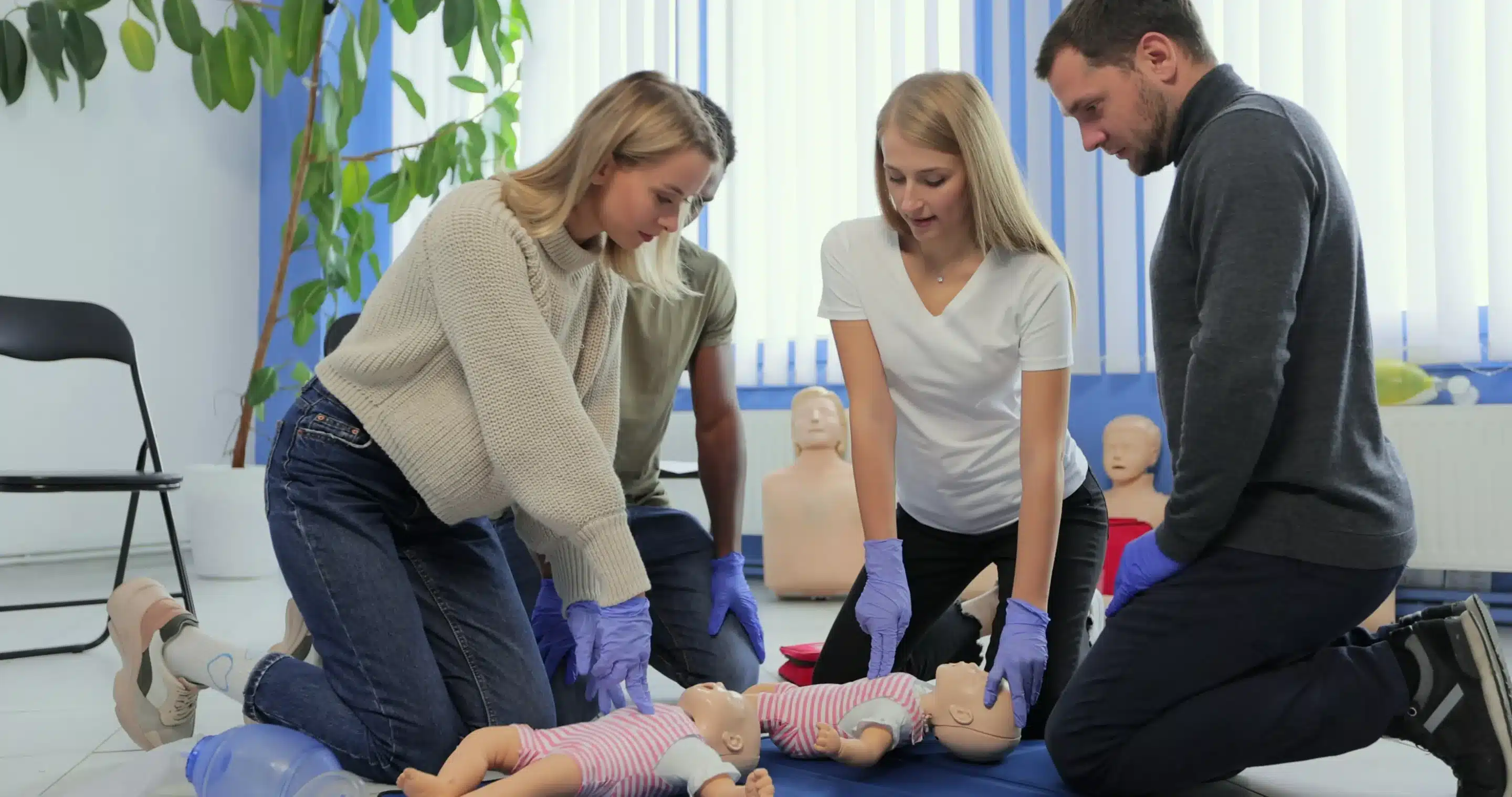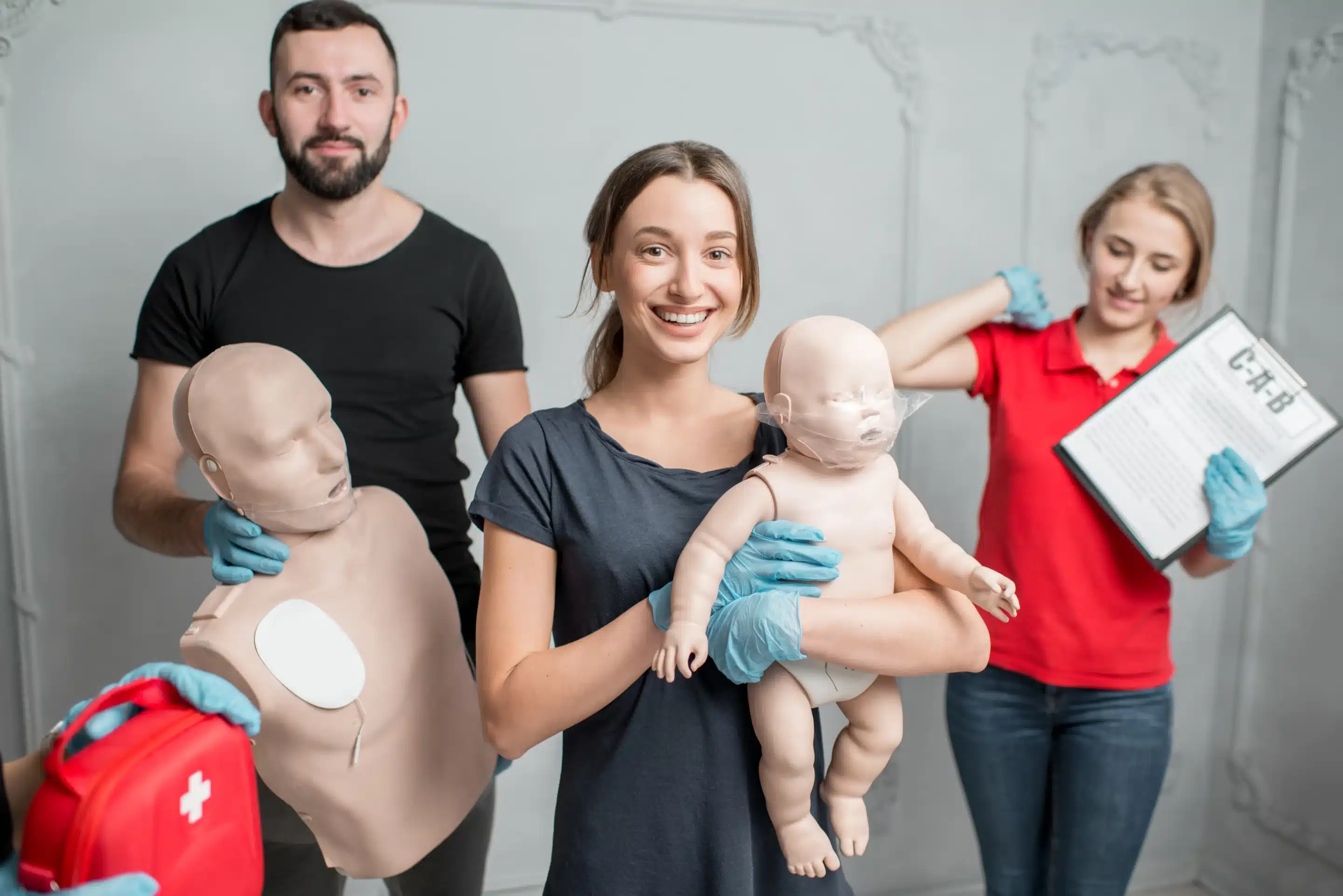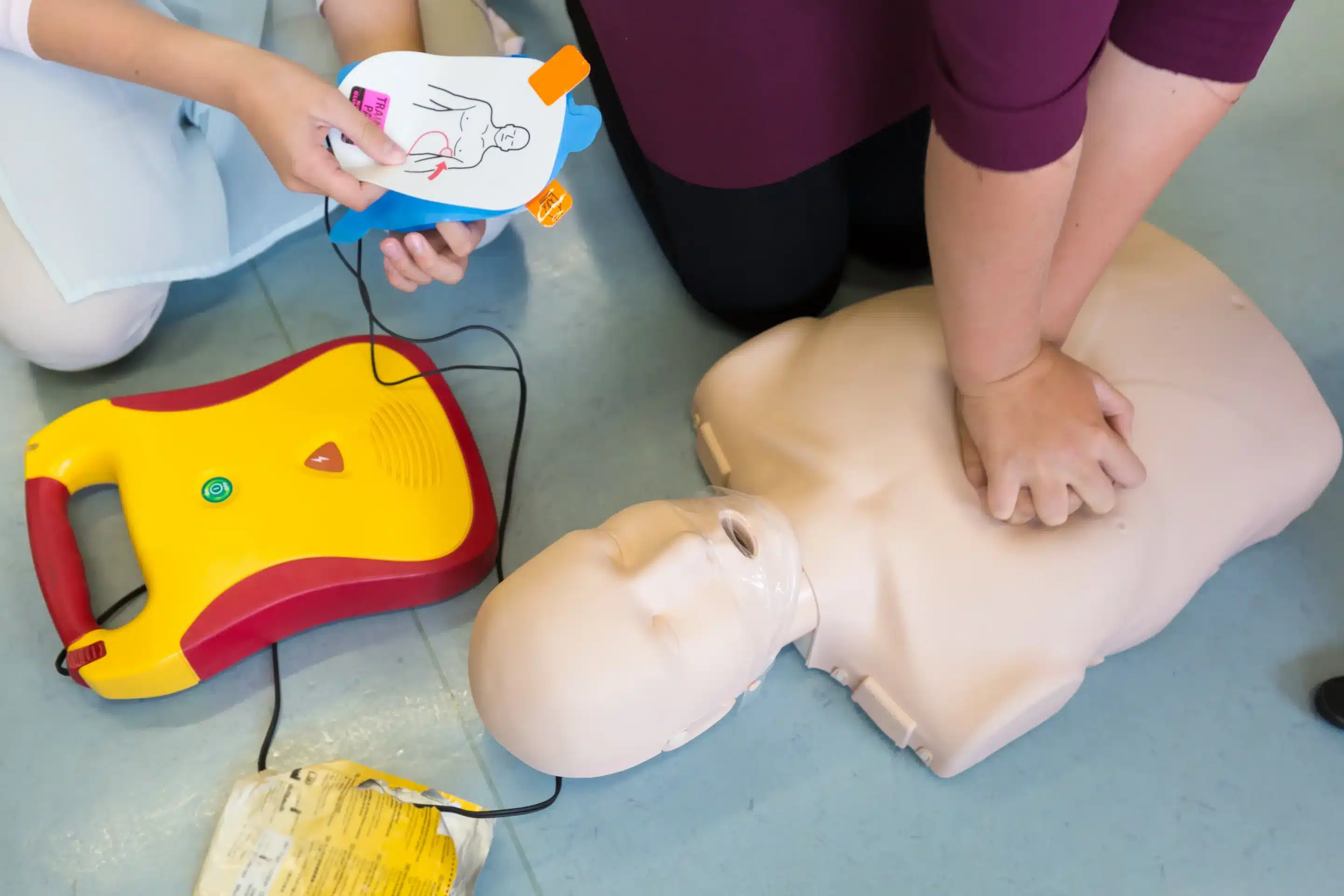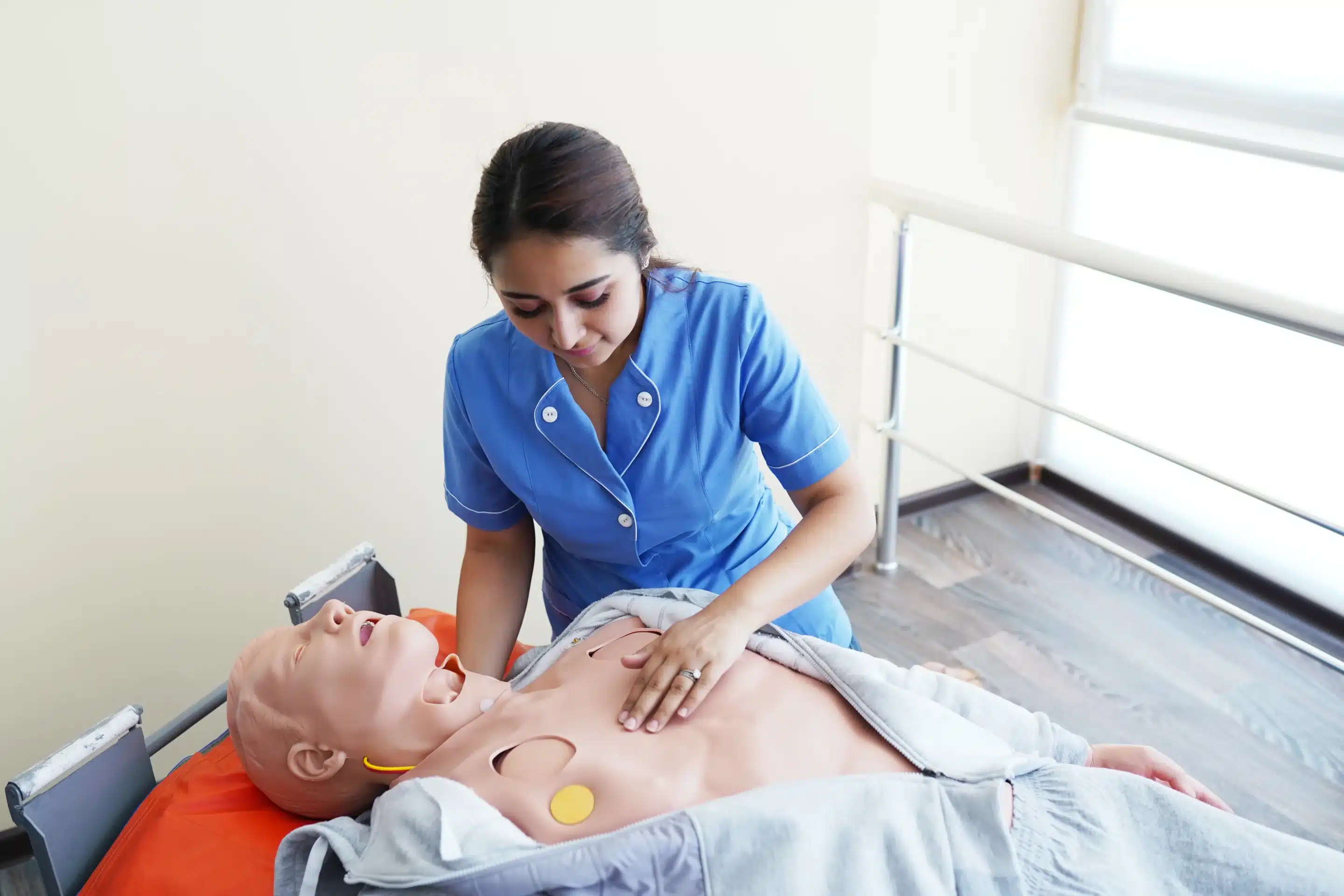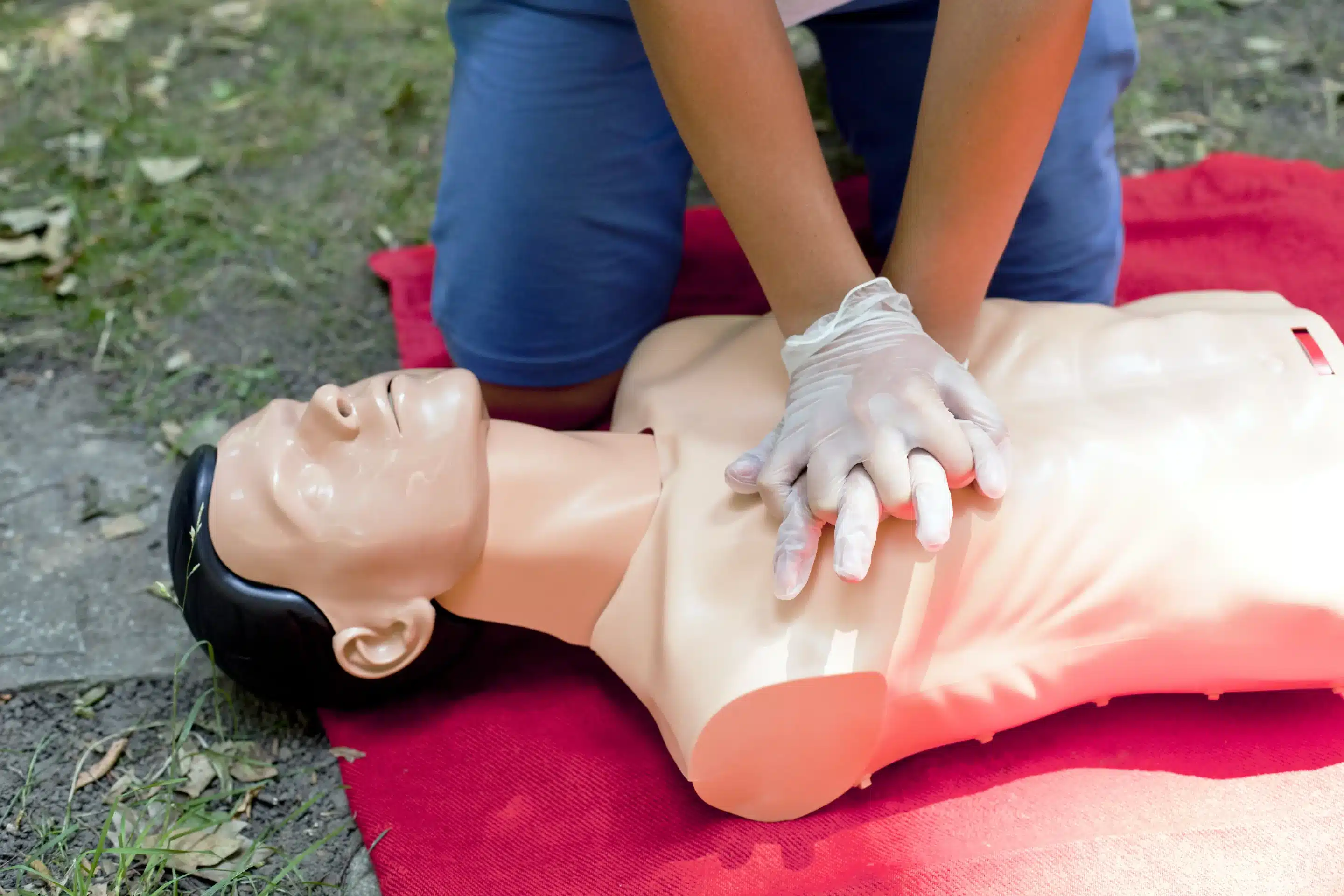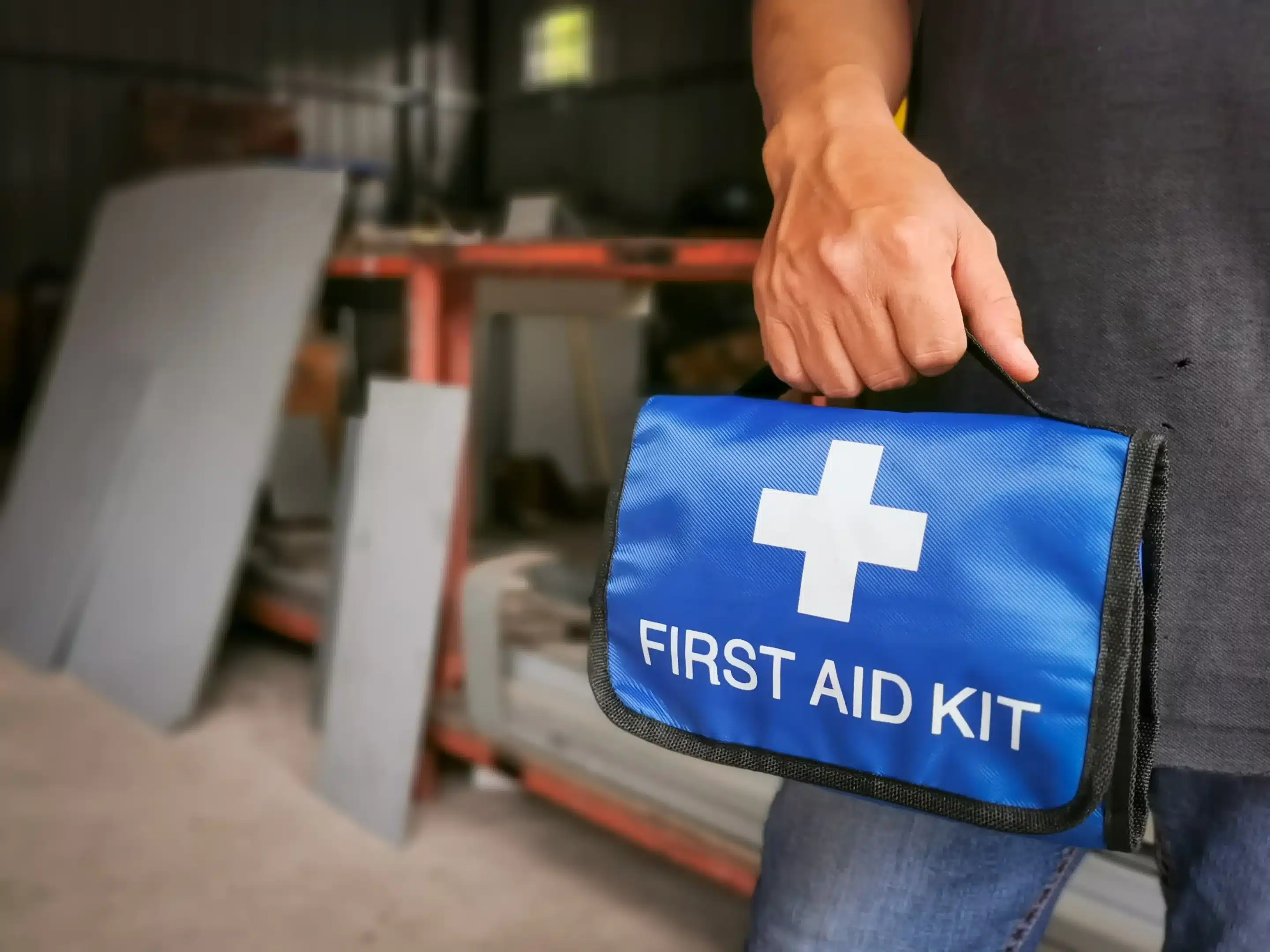Construction sites, with their heavy machinery and inherent risks, demand a higher level of preparedness. Accidents can happen in a split second, and knowing how to respond effectively can be the difference between life and death. This is why CPR training for construction workers in Bakersfield is not just a good idea—it’s a critical investment in the safety and well-being of your team. This article explores the specific reasons why CPR certification is so vital in the construction industry, the potential life-saving scenarios it prepares workers for, and how it contributes to a more confident and secure work environment. We’ll also discuss the requirements and regulations surrounding CPR training in Bakersfield and guide you toward choosing the right course for your construction crew.
Key Takeaways
- CPR is a vital skill for construction workers: Construction sites present unique risks, making CPR and first aid training essential for worker safety. These skills empower your team to respond effectively to emergencies, potentially saving lives and minimizing the severity of injuries.
- Select the right training for your team: Consider a comprehensive approach that combines BLS certification with first aid and AED training to address the diverse hazards of construction work. Look for training providers that offer flexible scheduling and group discounts to accommodate your team’s needs.
- Create a safety-conscious work environment: Integrate CPR training into a broader safety culture that emphasizes regular practice, clear emergency protocols, and open communication. Empowering employees to prioritize safety creates a more prepared, confident, and productive workforce.
Why Construction Workers Need CPR Training
Construction work is inherently risky. From heights to heavy machinery, construction sites present numerous hazards. CPR certification gives workers the skills to respond effectively in medical emergencies, potentially saving lives. Picture a coworker experiencing sudden cardiac arrest or a serious fall. Having trained personnel on-site who can administer CPR immediately can dramatically improve the chances of survival while waiting for professional medical help. Investing in CPR training demonstrates a commitment to worker safety and creates a more prepared and confident workforce.
Common CPR Misconceptions in Construction
One common misconception is that only healthcare professionals need to know CPR. This isn’t true. Anyone can learn and administer CPR effectively. Another misconception revolves around the fear of doing it wrong. While proper technique is essential, even imperfect CPR is better than none at all. Some hesitate due to concerns about mouth-to-mouth resuscitation, but current CPR guidelines emphasize chest compressions as the most critical component. Addressing these misconceptions is key to encouraging more construction workers to pursue certification.
Life-Saving Scenarios: Construction Sites
Imagine a worker falling from scaffolding and becoming unresponsive. A colleague trained in CPR can immediately assess the situation, begin chest compressions, and ensure the worker’s airway is open. This rapid response maintains vital blood flow and oxygen to the brain until paramedics arrive. Or, picture a worker experiencing a heart attack on site. CPR can help maintain blood circulation and significantly increase the chances of survival. In these critical moments, having CPR-trained individuals on a construction site can truly make a life-saving difference.
CPR Requirements in Construction: What You Need to Know
Working in construction has inherent risks. Accidents happen, and knowing how to respond effectively can save lives. This section clarifies CPR requirements for construction sites in Bakersfield and highlights why these skills are so vital.
California OSHA Job Site Regulations
California’s Occupational Safety and Health Administration (OSHA) regulations aim to protect workers across various industries, including construction. While OSHA doesn’t require CPR certification for every construction worker, the regulations stress the importance of prompt medical care, especially when workplaces are far from hospitals. This is particularly relevant for construction sites, which are often in remote locations with limited access to immediate medical assistance. OSHA guidelines recommend having at least one trained CPR provider on-site in these situations. This ensures someone can provide vital support during emergencies until professional medical help arrives. Learn more about these job site regulations and how they apply to your construction project.
Industry-Specific CPR Standards
Beyond OSHA regulations, the construction industry recognizes the specific risks inherent in its work environments. The hazardous nature of construction, involving heavy machinery, heights, and potentially dangerous materials, makes on-site CPR and first aid training essential. Industry best practices strongly encourage comprehensive CPR training for construction personnel. This equips workers to handle various emergencies, from falls and electrical incidents to sudden cardiac arrest. Regular CPR training updates are also vital, ensuring workers stay up-to-date on the latest procedures and best practices for using new equipment and handling hazardous materials safely. This proactive approach to safety creates a more secure work environment for everyone.
Choosing the Right CPR Course for Your Construction Team
Construction sites present unique safety challenges, demanding specialized first aid and CPR training. Equipping your team with the right skills goes beyond basic certification—it’s about empowering them to handle emergencies specific to your industry. This section helps you determine the most appropriate CPR course for your construction crew in Bakersfield.
BLS for Construction
Basic Life Support (BLS) is the cornerstone of CPR training for healthcare providers and many other professions. BLS certification covers core techniques like chest compressions, rescue breaths, and how to recognize the signs of a cardiac arrest. For construction workers, BLS provides a foundational understanding of how to respond to sudden cardiac events, a critical skill given the physically demanding nature of the job. The American Heart Association offers comprehensive BLS training that meets these essential requirements. In an industry fraught with potential hazards, having CPR-trained personnel on-site can mean the difference between life and death.
First Aid + CPR Combo Courses
While BLS focuses on life-threatening cardiac events, accidents on construction sites often involve injuries requiring immediate first aid. Cuts, burns, fractures, and other traumas are common occurrences. Knowing how to control bleeding, stabilize injuries, and provide initial care before professional medical help arrives is crucial. Combining CPR and first aid training equips your team with a broader range of skills to handle various on-site emergencies. This comprehensive approach ensures your workers can respond effectively to both life-threatening situations and everyday injuries, creating a safer work environment. Fast action in emergencies like heart attacks or heavy bleeding can dramatically improve outcomes, and training prepares workers to respond quickly and efficiently.
AED Training Essentials
Automated External Defibrillators (AEDs) are life-saving devices that can significantly increase the survival rate of sudden cardiac arrest victims. Learning how to properly use an AED is an essential component of CPR training for construction workers. AED training covers how to assess a situation, operate the device, and integrate its use with CPR techniques. Including AED training as part of your team’s CPR certification ensures they are fully prepared to utilize this critical technology in an emergency. CPR and AED training empowers construction workers with the skills to potentially save a colleague’s life.
Top CPR Training Providers in Bakersfield
Finding the right CPR training provider is crucial for construction companies. Here are a few reputable options in Bakersfield:
Bakersfield CPR Classes
Bakersfield CPR Classes offers a comprehensive range of American Heart Association (AHA) courses, including BLS, ACLS, PALS, and CPR/First Aid. They also offer the EMSA Child Care Health & Safety program and RQI programs for healthcare professionals. Their training equips participants with essential lifesaving skills tailored for various professional needs. You can explore their course offerings on their website.
Kern CPR
Kern CPR provides various CPR and first aid training courses throughout California, including online options. They hold certifications from several organizations, including the American Heart Association and the National Association of Emergency Technicians, ensuring high-quality training in BLS, PALS, ACLS, and more. Learn more about their programs.
Blue Ocean Safety
With over 20 years of experience, Blue Ocean Safety offers a wide range of workplace safety and first aid training courses in Bakersfield. Their OSHA-compliant programs include CPR and First Aid training specifically designed for construction and other high-risk industries. Visit the Blue Ocean Safety website for more information.
American Red Cross Bakersfield Chapter
The American Red Cross offers CPR classes in Bakersfield taught by experienced instructors. These courses meet OSHA requirements and provide participants with the skills to respond effectively to emergencies. Find a class near you.
Safety First CPR & Safety Training
Safety First CPR & Safety Training specializes in comprehensive CPR and first aid training tailored for various industries, including construction. Their courses emphasize practical skills and compliance with safety regulations, making them a solid choice for workers in high-risk environments. Check their website for more information.
CPR Training Costs vs. Benefits
Investing in CPR training might seem like an added expense, but it’s a smart, long-term investment in the safety and well-being of your construction team. Let’s weigh the costs against the significant benefits.
Course Pricing and Group Discounts
CPR certification costs in Bakersfield, much like elsewhere, vary based on several factors. The type of course (adult-only, child/infant, or all-inclusive), the class format (online, in-person, or blended learning), and the certification level influence the final price. A basic adult CPR course will typically cost less than a comprehensive BLS certification for healthcare providers. Many providers, such as Kern CPR, offer on-site group training, often a cost-effective option for training your entire construction crew. Contact training centers directly to discuss group discounts and tailor a solution to your team’s needs and budget.
Long-Term Impact on Workplace Safety
CPR training is more than just a checkbox on a safety list. It’s a vital investment in your team’s emergency preparedness. In the construction industry, where hazards are commonplace, having trained personnel on-site can significantly improve outcomes. CPR certification equips your workers to respond effectively in critical situations, potentially saving lives and minimizing injuries. This proactive approach fosters a culture of preparedness and can even boost employee retention. A safer work environment translates to a more productive one.
Implement CPR Training in Your Construction Business
CPR training is a smart investment for any business, but it’s especially critical for construction companies. Construction sites, by nature, present unique risks. Equipping your team with CPR and first aid skills can significantly reduce the severity of workplace incidents. This section offers actionable steps to seamlessly integrate CPR training into your Bakersfield construction business.
Create an Effective Training Schedule
Integrating CPR training into a busy construction schedule requires planning. Think about crew rotation on projects and how to minimize disruption to ongoing work. Aim for a schedule that ensures everyone receives initial training and stays current with recertification requirements. As CPR Fort Worth points out, having CPR-trained personnel on a construction site, an environment with inherent hazards, can be the difference between life and death.
Consider these tips for an effective training schedule:
- Onboarding: Include CPR training as part of new hire onboarding. This sets the tone for a safety-conscious work environment from the start.
- Regular Refreshers: Skills fade over time. Schedule regular refresher courses to keep everyone’s knowledge and skills sharp. Arise Safety emphasizes how important regular training updates are for new equipment and safety protocols.
- Toolbox Talks: Incorporate short, focused CPR and first aid reviews into your regular toolbox talks. This keeps safety top-of-mind and reinforces practical skills.
- Flexible Options: Explore options like blended learning (online coursework combined with in-person skills practice) to accommodate varying schedules and learning preferences. Bakersfield CPR Classes offers a range of courses to fit your needs.
Build a Safety-First Culture
CPR training is just one piece of the puzzle. To truly make a difference, cultivate a safety-first culture throughout your organization. When safety is a core value, everyone takes responsibility for their own well-being and that of their colleagues. Investing in CPR training demonstrates a commitment to employee safety, which can boost morale and even improve employee retention, as noted by CPR Classes NYC.
Here’s how to foster a safety-first mindset:
- Lead by Example: Management should actively participate in safety training and consistently emphasize its importance.
- Open Communication: Encourage open communication about safety concerns. Create a system where employees feel comfortable reporting potential hazards without fear of reprisal.
- Empowerment: Give employees the authority to stop work if they encounter unsafe conditions. This reinforces their role in maintaining a safe work environment.
- Recognition: Recognize and reward employees who demonstrate a commitment to safety. This could range from verbal praise to small incentives. CPR AED Course highlights how training increases safety awareness and can lead to better outcomes in emergencies. This proactive approach to safety is worth celebrating.
Keep CPR Skills Sharp on Construction Sites
Construction sites are dynamic environments. Dust, noise, and heavy equipment create an environment ripe for accidents. While aiming for a safe job site is key, knowing how to respond effectively during a crisis is crucial. That’s why maintaining sharp CPR skills is so vital for construction workers.
Regular Practice and Refresher Courses
CPR isn’t a one-and-done skill. Like any physical skill, regular practice is essential. Think of it like an athlete practicing drills—consistent training keeps responses sharp and automatic. The same principle applies to CPR. Regular practice builds muscle memory and reinforces the correct procedures, ensuring you can act quickly and confidently under pressure. Refresher CPR courses are also important. These courses reinforce existing knowledge and introduce any updated guidelines from the American Heart Association. Staying current with the latest recommendations can significantly impact the effectiveness of CPR in a real-world emergency.
Integrate CPR into Emergency Response Plans
Having trained personnel on-site is a good start, but integrating CPR training into your broader emergency response plan is even better. A comprehensive plan should include designated first aid responders, clearly marked first aid stations with accessible equipment, and regular drills to simulate emergency scenarios. These drills provide valuable practice and help identify any gaps in your current procedures. By making CPR training part of your overall safety strategy, you create a culture of preparedness and empower your team to respond swiftly and effectively to any medical crisis. This proactive approach enhances workplace safety and fosters a sense of confidence and teamwork. The American Red Cross offers valuable tools and information to help businesses create effective safety protocols.
Evaluate the Impact of CPR Training
After rolling out CPR training in your construction company, how can you measure its effectiveness? It’s about more than just checking a box—CPR training has a ripple effect across your entire operation. This section explores the key metrics to track and the positive changes you should observe in your team.
Key Safety Metrics to Monitor
CPR training equips your workers with the skills to respond effectively during emergencies. But how do you translate those skills into tangible improvements in safety? Start by tracking key safety metrics. Look for a reduction in the severity of workplace incidents involving cardiac arrest or near-drowning. Fewer lost-time injuries and a decrease in the need for emergency medical services are also positive indicators. While it’s impossible to predict every emergency, well-trained employees can significantly influence outcomes. For example, studies show that CPR and first aid training helps workers respond quickly to emergencies like heart attacks, ultimately improving the chances of survival. Remember, time is of the essence in these situations. Beyond the immediate response, CPR training increases overall safety awareness. When employees understand the principles of CPR, they become more attuned to potential hazards on the job site.
This heightened awareness can lead to a decrease in accidents overall, creating a safer work environment for everyone. Consider tracking near misses and safety violations to gauge this increased awareness. You might also see improvements in other safety-related areas, like proper use of personal protective equipment (PPE) and adherence to safety protocols. The ripple effect of CPR training can transform your safety culture. For instance, one in five sudden cardiac arrest deaths occurs in a place as vulnerable as a construction site, highlighting the importance of preparedness.
Employee Confidence and Preparedness
CPR training doesn’t just change behaviors; it changes mindsets. Employees who receive CPR training report feeling more confident in their ability to handle emergencies. This confidence translates to quicker, more decisive action when it matters most. Equipping your team with these skills empowers them to take charge in critical situations, potentially saving lives. Conduct regular surveys or feedback sessions to assess employee confidence levels and identify any remaining concerns. Beyond individual confidence, CPR training fosters a sense of collective preparedness. When team members know they can rely on each other in emergencies, it strengthens team cohesion and creates a more supportive work environment.
This shared sense of responsibility contributes to a stronger safety culture overall. Investing in CPR training demonstrates your commitment to employee well-being, which can boost morale and improve retention rates. A well-trained workforce is a more engaged and productive workforce.
Related Articles
- CPR & First Aid Training in Bakersfield: Your Guide – Bakersfield CPR Classes
- The Importance of CPR in Saving Lives – Bakersfield CPR Classes
- Essential Benefits of Workplace CPR and First-Aid Training
- CPR Certification in Rosedale: Your Complete Guide – Bakersfield CPR Classes
- Find CPR Classes Near Me: Your Complete Guide – Bakersfield CPR Classes
Frequently Asked Questions
Is CPR training legally required for all construction workers in California?
California OSHA doesn’t mandate CPR certification for every construction worker, but it strongly recommends having trained personnel on-site, especially in locations with limited access to immediate medical care. This guidance reflects the importance of prompt medical response in emergencies.
What are the main benefits of CPR training for construction companies?
CPR training equips construction workers with the skills to respond effectively to medical emergencies, potentially saving lives. It fosters a safety-conscious work environment, increases employee confidence, and can even improve employee retention. A safer work environment is a more productive work environment.
What type of CPR training is most suitable for construction workers?
While basic CPR certification is beneficial, BLS (Basic Life Support) is often recommended for construction workers due to its comprehensive nature. Combining CPR with first aid training provides a broader skill set for handling various on-site injuries. AED training is also highly valuable.
How can I implement CPR training effectively within my construction team’s busy schedule?
Integrate CPR training into new hire onboarding, schedule regular refresher courses, incorporate short CPR reviews into toolbox talks, and explore flexible training options like blended learning to accommodate various schedules.
How can I evaluate the impact of CPR training in my construction company?
Monitor key safety metrics such as the severity of workplace incidents, lost-time injuries, and the need for emergency medical services. Also, assess employee confidence levels and overall preparedness through surveys and feedback sessions. A positive shift in these areas indicates the effectiveness of your CPR training program.


